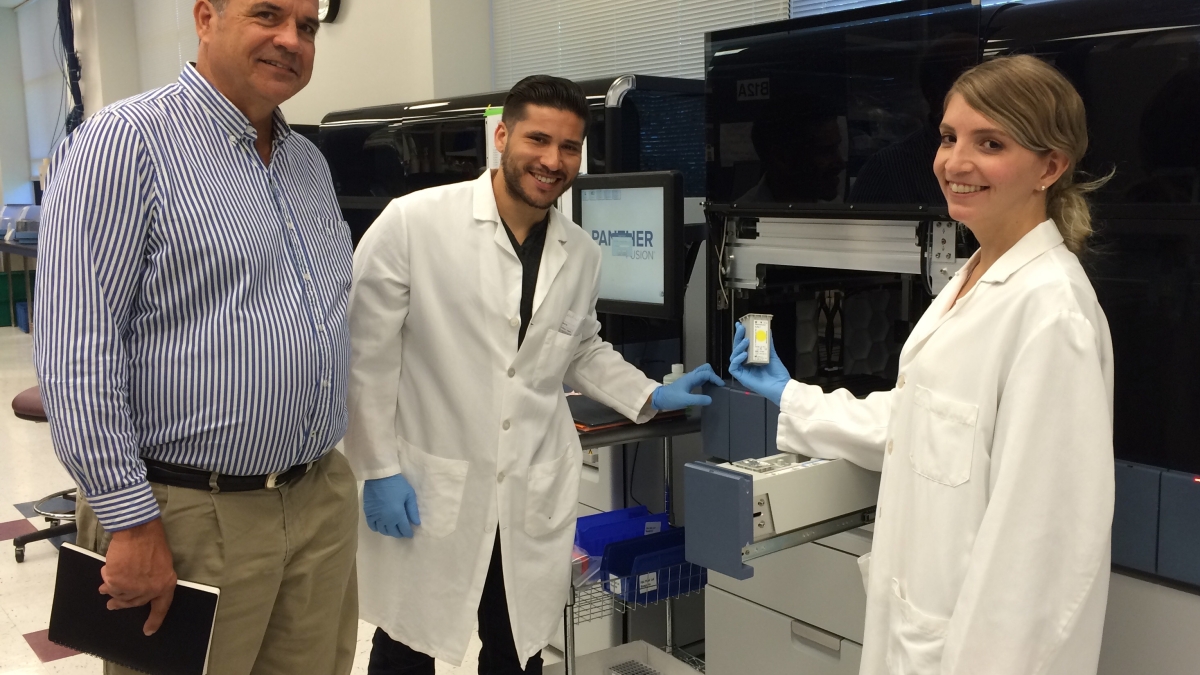ASU alumnus makes an impact on health care

Arizona State University alumnus Dan Kolk (left) works with laboratory assistants Artemio Saucedo and Kristina Young at Hologic, a global health-care and diagnostics company.
Arizona State University alumnus Daniel Kolk has merged his creative instincts with his education in molecular biology and virology to reimagine the future of molecular diagnostics and diagnostic medicine.
“We’re in the golden age of molecular biology,” said Kolk. “And we can make a difference quicker.”
Kolk received a bachelor’s degree in biochemistry and cell biology from the University of California, San Diego in 1983. He earned a doctoral degree in molecular genetics from ASU in 1992 and returned to UCSD’s School of Medicine to complete his post-doctoral work in 1995.
“I realized having the background of a PhD in hardcore molecular biology was absolutely essential to move forward in biotechnology,” said Kolk, who has been in the in vitro diagnostics industry for 20 years. “I worked a lot in mammalian cells at ASU and learned a tremendous amount about virology.”
Since 1995, Kolk has worked in assay development at Hologic, a global health care and diagnostics company formerly known as Gen-Probe. The company just received European regulatory approval for a molecular test to confirm Hepatitis C.
As the senior director of product development, Kolk helps create premium diagnostics for infectious diseases and ensures they are ready for clinical trials. He said the most fulfilling part of his job is developing some of the best products on the market to help people make informed medical decisions.
“The interesting thing about in vitro diagnostics is you can start developing something and see it on the market at four years or less,” he said. “I was attracted to this industry because I knew the turnaround time was faster … and it’s very inspirational to know people are using test results I helped generate.”
Kolk was named a 2016 CLAS Leader in honor of his contributions to in vitro diagnostics and his dedication to impacting health care. He was invited back to campus during homecoming to share his thoughts on the value of a liberal arts and sciences degree and induct the 2016 CLAS student leaders.
“I’m thrilled ASU recognizes there is a resource of successful graduates out there who can help with the success of futures graduates,” said Kolk.
Kolk has learned on his journey to success that perseverance is key. He encourages students to keep trying through periods of ups and downs to achieve both personal and professional success.
“If you really want to achieve your dream, you have to be willing to buckle down and solider through the down times because it’s inevitable that you’ll have them,” he said. “But in the long run, it will be more satisfying to know that you stuck with something through the tough times to achieve your goal.”
More Science and technology

ASU technical innovation enables more reliable and less expensive electricity
Growing demand for electricity is pushing the energy sector to innovate faster and deploy more resources to keep the lights on…

What do a spacecraft, a skeleton and an asteroid have in common? This ASU professor
NASA’s Lucy spacecraft will probe an asteroid as it flys by it on Sunday — one with a connection to the mission name.The asteroid…

Hack like you 'meme' it
What do pepperoni pizza, cat memes and an online dojo have in common?It turns out, these are all essential elements of a great…

